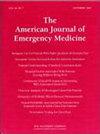External evaluation of Brain Injury Guideline (BIG) low risk criteria for traumatic brain injury
IF 2.7
3区 医学
Q1 EMERGENCY MEDICINE
引用次数: 0
Abstract
Background
Fewer than 20 % of traumatic brain injury (TBI) cases with traumatic intracranial hemorrhage (ICH) result in clinical deterioration. The Brain Injury Guideline (BIG) criteria were published in 2014 and categorize patients with TBI into three risk groups (BIG 1, 2, and 3) based on CT scan findings, neurological examination, anti-coagulant/platelet medications, and intoxication. Early data is promising, suggesting no instances of neurosurgical intervention or death in the low-risk BIG1 category within 30 days. We sought to externally validate the BIG criteria and identify patients with TBI at low risk of clinical deterioration. We hypothesized that patients meeting the BIG1 low risk criteria have less than a 1 % risk of death or neurosurgical intervention.
Methods
We performed a retrospective cohort study of a level 1 trauma center's trauma registry records from 2011 to 2022 to identify patients with head trauma. We abstracted demographics, injury characteristics, clinical course, CT imaging results, and outcomes, and we categorized patients according to the BIG criteria. The Clopper-Pearson Exact method was used to estimate outcome frequency with confidence intervals. The primary outcome was death or neurosurgical intervention within 30 days. Secondary outcomes included progression on repeat head CT (RHCT), ICU admission with neurocritical care intervention, and TBI-related hospital readmission within 30 days.
Results
A total of 1714 patients with TBI with ICH were identified from the trauma registry. 325 patients were excluded due to missing data, pregnancy, incarceration, polytrauma, or GCS < 13, leaving 1389 for analysis. 193 patients (13.9 %) were classified as BIG1. No patients classified as BIG1 experienced the primary outcome measures of death or neurosurgical intervention (95 % confidence interval [CI]: 0 %–1.9 %). The number of patients who experienced the secondary outcome measures of progression on RHCT, ICU admission with neurocritical care intervention, or TBI-related hospital readmission within 30 days were 9 (4.7 %, 95 % CI: 2.2 %–8.7 %), 1 (0.5 %, 95 % CI: 0 %–2.9 %), and 4 (2.1 %, 95 % CI: 0.6 %–5.2 %), respectively.
Conclusion
BIG1 criteria identified a low-risk subset of patients with TBI with ICH. However, an upper 95 % CI of 1.9 % does not exclude the risk of neurologic deterioration being <1 %. Validation of these criteria in larger cohorts is warranted.
对《脑损伤指南》(BIG)创伤性脑损伤低风险标准进行外部评估
背景在创伤性脑损伤(TBI)病例中,只有不到 20% 的创伤性颅内出血(ICH)会导致临床病情恶化。脑损伤指南(BIG)标准于 2014 年发布,根据 CT 扫描结果、神经系统检查、抗凝血剂/血小板药物和中毒情况将 TBI 患者分为三个风险组(BIG 1、2 和 3)。早期数据显示,低风险 BIG1 组在 30 天内没有神经外科干预或死亡病例。我们试图从外部验证 BIG 标准,并确定临床恶化风险较低的创伤性脑损伤患者。我们假设符合 BIG1 低风险标准的患者的死亡或神经外科干预风险低于 1%。方法我们对一级创伤中心 2011 年至 2022 年的创伤登记记录进行了回顾性队列研究,以确定头部创伤患者。我们摘录了人口统计学特征、损伤特征、临床过程、CT成像结果和预后,并根据BIG标准对患者进行了分类。我们采用 Clopper-Pearson 精确法来估计结果频率和置信区间。主要结果是 30 天内死亡或神经外科干预。次要结果包括重复头部 CT(RHCT)的进展、入住 ICU 并接受神经重症监护干预以及 30 天内与 TBI 相关的再入院治疗。由于数据缺失、怀孕、监禁、多发性创伤或 GCS < 13 等原因,325 名患者被排除在外,剩下 1389 名患者用于分析。193名患者(13.9%)被归类为BIG1。没有归类为 BIG1 的患者出现死亡或神经外科干预(95% 置信区间 [CI]:0 %-1.9 %)这一主要结果指标。30天内出现RHCT进展、入住ICU并接受神经重症监护干预或TBI相关再入院等次要结局指标的患者人数分别为9人(4.7%,95% CI:2.2%-8.7%)、1人(0.5%,95% CI:0%-2.9%)和4人(2.1%,95% CI:0.6%-5.2%)。然而,1.9%的95% CI上限并不能排除神经功能恶化的风险。有必要在更大的群体中验证这些标准。
本文章由计算机程序翻译,如有差异,请以英文原文为准。
求助全文
约1分钟内获得全文
求助全文
来源期刊
CiteScore
6.00
自引率
5.60%
发文量
730
审稿时长
42 days
期刊介绍:
A distinctive blend of practicality and scholarliness makes the American Journal of Emergency Medicine a key source for information on emergency medical care. Covering all activities concerned with emergency medicine, it is the journal to turn to for information to help increase the ability to understand, recognize and treat emergency conditions. Issues contain clinical articles, case reports, review articles, editorials, international notes, book reviews and more.

 求助内容:
求助内容: 应助结果提醒方式:
应助结果提醒方式:


